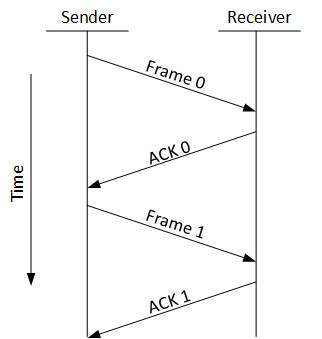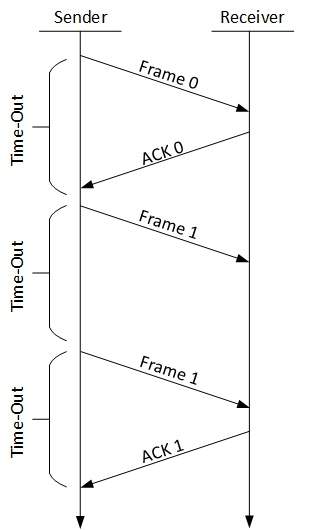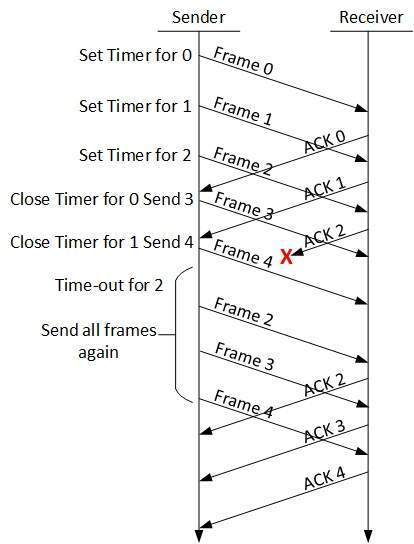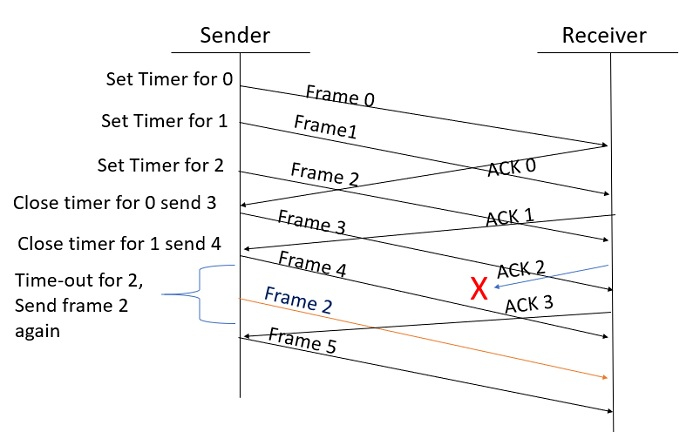- Data-link layer is responsible for implementation of point-to-point flow and error control mechanism.
Flow Control
- When a data frame (Layer-2 data) is sent from one host to another over a single medium, it is required that the sender and receiver should work at the same speed.
- That is, sender sends at a speed on which the receiver can process and accept the data. What if the speed (hardware/software) of the sender or receiver differs?
- If sender is sending too fast the receiver may be overloaded, (swamped) and data may be lost.
Two types of mechanisms can be deployed to control the flow
Stop and Wait
- This flow control mechanism forces the sender after transmitting a data frame to stop and wait until the acknowledgement of the data-frame sent is received.

Sliding Window
- In this flow control mechanism, both sender and receiver agree on the number of data-frames after which the acknowledgement should be sent.
- As we learnt, stop and wait flow control mechanism wastes resources, this protocol tries to make use of underlying resources as much as possible.
Error Control
- When data-frame is transmitted, there is a probability that data-frame may be lost in the transit or it is received corrupted.
- In both cases, the receiver does not receive the correct data-frame and sender does not know anything about any loss.
- In such case, both sender and receiver are equipped with some protocols which helps them to detect transit errors such as loss of data-frame.
- Hence, either the sender retransmits the data-frame or the receiver may request to resend the previous data-frame.
Requirements for error control mechanism
Error detection - The sender and receiver, either both or any, must ascertain that there is some error in the transit.
- When the receiver receives a correct frame, it should acknowledge it.
- When the receiver receives a damaged frame or a duplicate frame, it sends a NACK back to the sender and the sender must retransmit the correct frame.
- The sender maintains a clock and sets a timeout period. If an acknowledgement of a data-frame previously transmitted does not arrive before the timeout the sender retransmits the frame, thinking that the frame or it’s acknowledgement is lost in transit.
- There are three types of techniques available which Data-link layer may deploy to control the errors by Automatic Repeat Requests (ARQ).
Stop-and-wait ARQ

The following transition may occur in Stop-and-Wait ARQ:
- The sender maintains a timeout counter.
- When a frame is sent, the sender starts the timeout counter.
- If acknowledgement of frame comes in time, the sender transmits the next frame in queue.
- If acknowledgement does not come in time, the sender assumes that either the frame or its acknowledgement is lost in transit. Sender retransmits the frame and starts the timeout counter.
- If a negative acknowledgement is received, the sender retransmits the frame.
Go-Back-N ARQ
- Stop and wait ARQ mechanism does not utilize the resources at their best.When the acknowledgement is received, the sender sits idle and does nothing.
- In Go-Back-N ARQ method, both sender and receiver maintain a window.

- The sending-window size enables the sender to send multiple frames without receiving the acknowledgement of the previous ones.
- The receiving-window enables the receiver to receive multiple frames and acknowledge them. The receiver keeps track of incoming frame’s sequence number.
- When the sender sends all the frames in window, it checks up to what sequence number it has received positive acknowledgement.
- If all frames are positively acknowledged, the sender sends next set of frames. If sender finds that it has received NACK or has not receive any ACK for a particular frame, it retransmits all the frames after which it does not receive any positive ACK.
Selective Repeat ARQ
- In Go-back-N ARQ, it is assumed that the receiver does not have any buffer space for its window size and has to process each frame as it comes.
- This enforces the sender to retransmit all the frames which are not acknowledged.

- In Selective-Repeat ARQ, the receiver while keeping track of sequence numbers, buffers the frames in memory and sends NACK for only frame which is missing or damaged.
- The sender in this case, sends only packet for which NACK is received.









Download Speed Test
ReplyDeleteUpload Speed Test